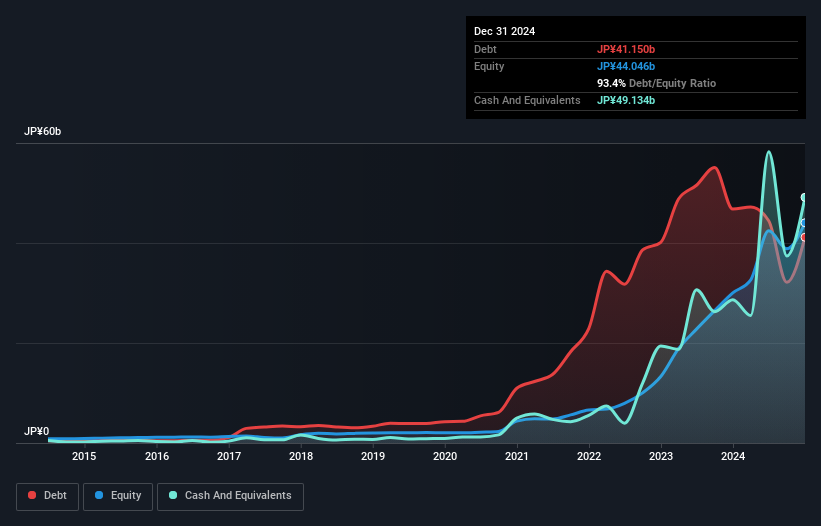Howard Marks put it nicely when he said that, rather than worrying about share price volatility, 'The possibility of permanent loss is the risk I worry about... and every practical investor I know worries about.' When we think about how risky a company is, we always like to look at its use of debt, since debt overload can lead to ruin. We can see that Abalance Corporation (TSE:3856) does use debt in its business. But the real question is whether this debt is making the company risky.
What Risk Does Debt Bring?
Debt and other liabilities become risky for a business when it cannot easily fulfill those obligations, either with free cash flow or by raising capital at an attractive price. Ultimately, if the company can't fulfill its legal obligations to repay debt, shareholders could walk away with nothing. However, a more common (but still painful) scenario is that it has to raise new equity capital at a low price, thus permanently diluting shareholders. Of course, debt can be an important tool in businesses, particularly capital heavy businesses. The first step when considering a company's debt levels is to consider its cash and debt together.
What Is Abalance's Debt?
As you can see below, Abalance had JP¥41.2b of debt at December 2024, down from JP¥46.8b a year prior. But on the other hand it also has JP¥49.1b in cash, leading to a JP¥7.98b net cash position.

A Look At Abalance's Liabilities
According to the last reported balance sheet, Abalance had liabilities of JP¥75.3b due within 12 months, and liabilities of JP¥22.4b due beyond 12 months. Offsetting this, it had JP¥49.1b in cash and JP¥11.1b in receivables that were due within 12 months. So its liabilities total JP¥37.5b more than the combination of its cash and short-term receivables.
The deficiency here weighs heavily on the JP¥10.0b company itself, as if a child were struggling under the weight of an enormous back-pack full of books, his sports gear, and a trumpet. So we definitely think shareholders need to watch this one closely. After all, Abalance would likely require a major re-capitalisation if it had to pay its creditors today. Abalance boasts net cash, so it's fair to say it does not have a heavy debt load, even if it does have very significant liabilities, in total.
Check out our latest analysis for Abalance
But the other side of the story is that Abalance saw its EBIT decline by 8.7% over the last year. If earnings continue to decline at that rate the company may have increasing difficulty managing its debt load. There's no doubt that we learn most about debt from the balance sheet. But it is Abalance's earnings that will influence how the balance sheet holds up in the future. So if you're keen to discover more about its earnings, it might be worth checking out this graph of its long term earnings trend .
Finally, a company can only pay off debt with cold hard cash, not accounting profits. While Abalance has net cash on its balance sheet, it's still worth taking a look at its ability to convert earnings before interest and tax (EBIT) to free cash flow, to help us understand how quickly it is building (or eroding) that cash balance. Over the most recent three years, Abalance recorded free cash flow worth 68% of its EBIT, which is around normal, given free cash flow excludes interest and tax. This free cash flow puts the company in a good position to pay down debt, when appropriate.
Summing Up
Although Abalance's balance sheet isn't particularly strong, due to the total liabilities, it is clearly positive to see that it has net cash of JP¥7.98b. And it impressed us with free cash flow of JP¥13b, being 68% of its EBIT. So although we see some areas for improvement, we're not too worried about Abalance's balance sheet. When analysing debt levels, the balance sheet is the obvious place to start. But ultimately, every company can contain risks that exist outside of the balance sheet. Be aware that Abalance is showing 2 warning signs in our investment analysis , you should know about...
If, after all that, you're more interested in a fast growing company with a rock-solid balance sheet, then check out our list of net cash growth stocks without delay.
New: Manage All Your Stock Portfolios in One Place
We've created the ultimate portfolio companion for stock investors, and it's free.
• Connect an unlimited number of Portfolios and see your total in one currency
• Be alerted to new Warning Signs or Risks via email or mobile
• Track the Fair Value of your stocks
Have feedback on this article? Concerned about the content? Get in touch with us directly. Alternatively, email editorial-team (at) simplywallst.com.
This article by Simply Wall St is general in nature. We provide commentary based on historical data and analyst forecasts only using an unbiased methodology and our articles are not intended to be financial advice. It does not constitute a recommendation to buy or sell any stock, and does not take account of your objectives, or your financial situation. We aim to bring you long-term focused analysis driven by fundamental data. Note that our analysis may not factor in the latest price-sensitive company announcements or qualitative material. Simply Wall St has no position in any stocks mentioned.
About TSE:3856
Abalance
Engages in renewable energy, construction machinery, IT, and photocatalyst businesses in Japan.
Excellent balance sheet with slight risk.
Market Insights
Community Narratives




